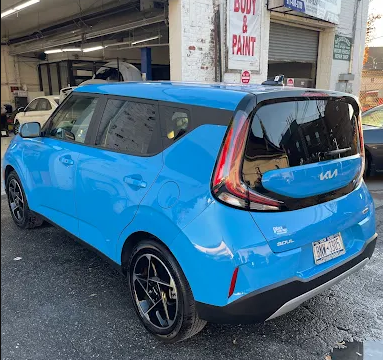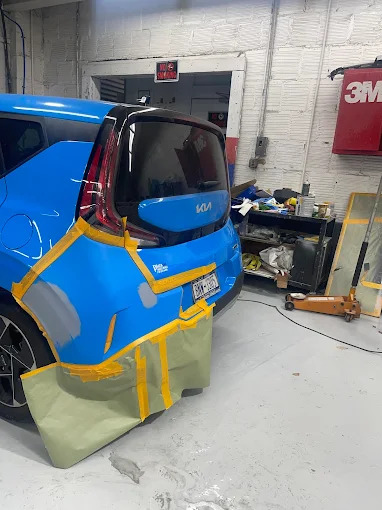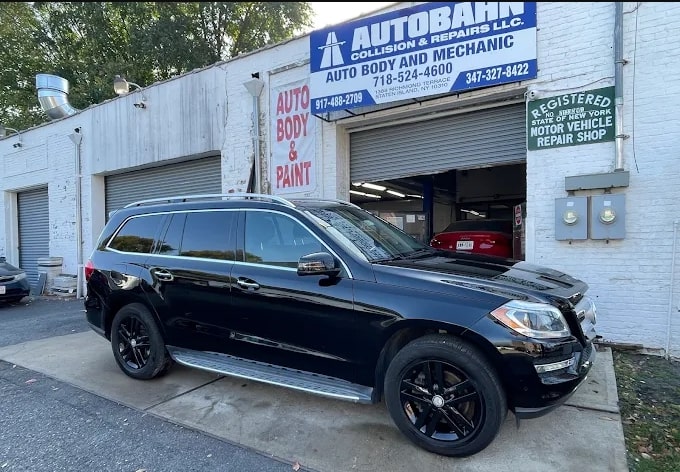How does the collision repair process work?
The collision repair process moves in a clear sequence: assessment and estimate, disassembly and damage mapping, parts planning, structural and mechanical repairs, bodywork, paint and refinishing, reassembly, ADAS calibration, quality control, final inspection, and delivery to restore safety, function, and appearance. It’s normal for hidden issues to appear during teardown, which can change the plan and timeline through insurer-approved supplements to protect the vehicle’s integrity. Modern cars require electronic scans and system calibrations in addition to traditional bodywork, so reputable shops follow OEM procedures with trained technicians and proper equipment.
At‑a‑glance workflow
- Intake, assessment, and estimate approval.
- Teardown, damage mapping, and supplemental approvals.
- Parts sourcing and scheduling.
- Structural/frame and mechanical repairs.
- Bodywork and panel repair/replace.
- Paint preparation, color match, and refinishing.
- Reassembly, post-scan, and ADAS calibration.
- Road test, multi-point QC, detail, and delivery.
First steps after an accident
Safety comes first: move to a safe spot, document the scene, photograph damage, and gather driver and insurance details to start a claim promptly. Choose a shop early so the vehicle can be inspected, documented, and scheduled, which accelerates approvals and parts ordering. Clear early communication reduces delays later when supplements or calibrations are needed.

Initial assessment and repair estimate
Technicians conduct a visual and functional inspection of exterior, interior, and critical systems to outline a preliminary cost and time estimate. This estimate guides initial approvals and parts planning while setting expectations about possible hidden damage discovered after teardown. Shops increasingly pair inspections with digital scans to capture non-visible issues in safety systems.
Digital pre‑scan and diagnostics
A pre-scan pulls diagnostic trouble codes that point to sensor, restraint, or network problems that aren’t obvious to the eye. These findings inform the repair plan, including wiring checks, module replacements, and planned calibrations to restore system function. Pre-scan results also document the pre-repair state for insurers and final post-scan comparisons.
Disassembly and damage mapping (teardown)
Teardown removes damaged parts to reveal hidden structural, mechanical, or electrical damage and updates the repair plan accordingly. Comprehensive damage mapping reduces rework, improves parts accuracy, and ensures the sequence of operations follows OEM methods. Teardown findings commonly trigger supplements for insurer approval before work proceeds.
Supplements and insurer authorization
When new damage is documented, the shop submits a supplement for cost and time adjustments, then resumes work once authorized. This step prevents unsafe shortcuts by aligning scope with the vehicle’s actual condition. Expect timeline changes if structural components, sensors, or specialty materials are affected.
Parts strategy: OEM, aftermarket, recycled
Selecting OEM, aftermarket, or recycled parts depends on safety, fit, policy, and availability, with OEM often preferred for structural and safety-critical components. Quality recycled parts may be appropriate for cosmetics when fit and corrosion protection are verified. A clear parts plan helps minimize delays and ensures blending and alignment go smoothly.
Lead times and availability impacts
Special orders, backorders, and shipping times can add days to the repair timeline, especially for sensors, aluminum panels, or brand-new model years. Shops typically schedule body and paint stages around confirmed parts’ arrival to avoid idle time. Asking for parts ETAs upfront helps set realistic delivery targets.
Structural and frame repairs
If measurements show structural deviation, technicians use precision benches and measuring systems to restore geometry to factory specs. Proper straightening ensures panels fit, alignment can be set, and crash energy paths perform as designed. OEM procedures guide locations and types of welds, reinforcements, or sectioning to maintain integrity.
Unibody measurements and welding methods
Modern unibodies often require spot welding, MIG brazing, or structural adhesives per OEM instructions to control heat and preserve strength. Documented measurements before and after repairs prove the structure is back in spec. Skipping approved joining methods risks corrosion, noise, and compromised crash performance.
Mechanical and suspension repairs
Collision forces can damage radiators, steering, suspension arms, mounts, and driveline parts that must be inspected and repaired. Mechanical work often runs in parallel with structural and body stages to compress timelines. Finishing mechanical items before alignment and calibrations avoids rework.
Wheel alignment and steering geometry
Post-repair alignment sets toe, camber, and caster to ensure straight tracking, proper tire wear, and stable handling. Correct geometry also supports ADAS functions like lane-keeping and collision warning that depend on true vehicle thrust lines. A road test verifies no pulls, vibrations, or noises after alignment.
Bodywork and panel replacement
Technicians repair dents, reshape metal, or replace panels based on severity, cost, and OEM repairability limits. Careful test-fitting ensures even gaps and flush surfaces to minimize filler and enhance final paint results. When panels are replaced, corrosion protection and seam sealing are restored before paint prep.
PDR vs filler vs replace
Paintless dent repair suits small, accessible dents that haven’t stretched metal or cracked paint. Filler-based refinishing works for moderate dents, while severe creases, tears, or compromised edges usually require replacement. Shops weigh safety, longevity, and cost to choose the right path.
Corrosion protection and seam sealing
After cutting or welding, technicians reapply seam sealers, cavity wax, and primers to block moisture and prevent future rust. These steps are essential on mixed-material bodies where dissimilar metals can accelerate corrosion. Skipping protection can shorten the life of an otherwise solid repair.
Adhesives, substrates, and OEM procedures
Structural adhesives and rivet-bonding are common on aluminum, UHSS, and composites and must follow OEM specs for bond prep, cure, and clamping. Substrate-safe abrasives and cleaners prevent micro-damage that weakens bonds. Following SOPs also improves paint adhesion and long-term durability.

Paint preparation and refinishing
Surface prep includes sanding, priming, masking, and cleanliness controls before basecoat and clearcoat in a controlled booth. Technicians use spray-outs and digital tinting to nail the match before blending adjacent panels. Proper flash and cure times deliver gloss, color depth, and lasting protection.
Color matching and blending
Even factory colors vary by batch and sun exposure, so blending adjoining panels hides edge differences. Computerized formulas are fine-tuned by test panels for an invisible transition under different lighting. Good blending reduces the need to repaint larger areas than necessary.
Reassembly and systems checks
Reassembly restores trim, glass, lighting, sensors, and interior components while verifying wiring routes, clips, and seals. Electrical checks confirm lights, windows, cameras, and modules operate normally before post-scan. Fit checks ensure gaps, flushness, and squeak/rattle prevention.
ADAS calibration and post‑scan
Static and dynamic calibrations align cameras, radar, and lidar after structural work, windshield replacement, or alignment. A post-scan verifies fault codes are cleared and systems are ready for the road. Skipping calibration can degrade braking assistance, lane-keeping, or collision warning accuracy.
Quality control, road test, and detailing
QC teams inspect panel fit, paint finish, functions, fluid levels, and warning lights before a road test. The road test checks alignment, handling, brakes, and noise/leak conditions under real conditions. A final detail prepares the vehicle for a customer walkthrough and delivery.
Customer walkthrough and documentation
Expect a repair report review, paint match check, panel-gap inspection, and an explanation of any warranties. Verify doors, windows, locks, lights, sensors, and ADAS features perform correctly. Ask for copies of alignment specs, calibration results, and scan reports for your records.
Timeline: what to expect
Minor repairs can be completed in two to three days once parts are available, while structural or complex jobs often take a week or more. Paint stages add up to several days depending on prep, booth scheduling, and curing. Final QC and delivery typically add another day for testing and detail.
Factors that change duration
Parts backorders, insurer supplement approvals, calibrations, and specialty materials can extend timelines. Newer models and ADAS-heavy vehicles often require more scans, setup time, and test drives. Early expectations and milestone updates help keep surprises to a minimum.
Cost, supplements, and approvals
Initial estimates cover visible work, while supplements add approved operations as hidden damage is uncovered. Deductibles, coverage limits, and parts choices influence out-of-pocket costs. Transparent documentation supports fair claims and safe outcomes.
Rental vehicles, DRP vs independent shops
Insurer direct-repair programs may streamline communication and approvals, while independent shops can offer broader parts options or brand-specific certifications. Ask about rental coverage duration and extensions tied to parts or supplements to avoid gaps. Choose based on capability, not just convenience.
Total loss and diminished value
A vehicle may be declared a total loss when repair cost plus related expenses exceed a threshold of the vehicle’s value. After repairs, some owners pursue diminished value claims when a vehicle’s market value remains lower despite quality repairs. Documentation from the shop helps inform these discussions.
Choosing a certified body shop
Look for current equipment, OEM procedures, written SOPs, and evidence of training on modern materials, adhesives, and calibrations. Facility cleanliness and process control often reflect repair consistency and safety culture. Ask to see sample scan, alignment, and calibration reports.
I‑CAR Gold and OEM approvals
I-CAR Gold and automaker approvals signal training, tooling, and process discipline to meet modern repair demands. These programs typically require ongoing education and proof of capability with new substrates and joining methods. Certifications complement, but do not replace, detailed OEM procedures for each model.
Warranty, care, and aftercare
Many shops offer workmanship and paint warranties; ask what’s covered and how to maintain eligibility. Fresh paint benefits from gentle washing and avoiding harsh chemicals or abrasives during initial cure periods. Schedule a follow-up inspection if any fit, finish, or function concerns arise.
New paint curing and maintenance
Follow the shop’s guidelines for the first 30–60 days regarding washing, waxing, and exposure to severe weather to preserve the finish. Micro-scratches often come from improper washing, so use clean mitts and safe drying towels. Quick inspections after a few heat cycles can catch minor issues before they grow.

Common pitfalls to avoid
Rushing approvals, skipping calibrations, or accepting ill-fitting parts can compromise safety and appearance. Failing to document supplements or QC checks makes it harder to resolve disputes or future concerns. Clear milestone updates and signoffs help keep the project on track.
Communication milestones to request
- Parts ETA and backorder status.
- Structural completion date and measurement report.
- Paint booth schedule and blend plan.
- Alignment specs and ADAS calibration appointment.
- Final QC road test and delivery window.
Parts comparison table
| Parts type | Safety-critical use | Fit/finish consistency | Cost/availability | Notes |
| OEM | Preferred for structural/sensor areas to match design specs. | High, designed to factory tolerances. | Higher cost, variable stock. | Supports OEM repair procedures and calibrations. |
| Aftermarket | Limited for safety-critical; case-by-case. | Variable; may need extra fitting. | Lower cost, often in stock. | Evaluate certification and corrosion protection. |
| Recycled | Suitable for cosmetic/non-structural with inspection. | Good if undamaged and matched. | Moderate cost, depends on sourcing. | Inspect for hidden damage and rust. |
FAQs
How does the collision repair process work with my insurance?
The shop creates an initial estimate, performs teardown to find hidden damage, and submits supplements for insurer approval before proceeding to ensure safe, complete repairs.
How does the collision repair process work for EVs and hybrids?
Expect additional high-voltage safety procedures, battery inspections, coolant checks, and ADAS calibrations, often adding setup time and specialized tooling to the plan.
How does the collision repair process work when parts are backordered?
Shops typically pause scheduling body and paint stages until critical parts have confirmed
ETAs to avoid stalls, with delivery adjusted as updates arrive.
How does the collision repair process work if the frame is damaged?
Technicians measure and straighten the structure on a bench to factory specs, verify alignment, then proceed with bodywork, paint, reassembly, and calibrations.
How does the collision repair process work for ADAS sensors and cameras?
Pre-scan identifies faults, repairs restore mounting geometry, then static/dynamic calibrations and a post-scan confirm the systems meet operational targets.
How does the collision repair process work at pickup time?
A walkthrough covers the repair report, fit and finish, alignment and calibration results, and warranty terms before the final handoff.
Conclusion
Safe, lasting collision repair follows a disciplined sequence—from accurate assessment and teardown to OEM‑driven structural work, careful refinishing, thorough reassembly, and validated calibrations—ending with road-tested quality control and a documented handoff. Asking about parts strategy, milestones, and scan/calibration reports keeps expectations aligned and outcomes consistent. Choosing tr
